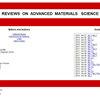纤维处理对天然纤维增强复合材料物理力学性能的影响
IF 3.6
4区 材料科学
Q2 MATERIALS SCIENCE, MULTIDISCIPLINARY
引用次数: 0
摘要
由于对环境和财务的考虑,在包括建筑和汽车工业在内的广泛行业中,对复合材料的需求不断增长。到2020年,木塑复合材料市场估计价值54亿美元。到2030年,预计将增长到126亿美元,2021年至2030年的复合年增长率为8.9%。天然纤维增强复合材料的根本缺点是亲水性木质纤维素和疏水性热塑性聚合物的性质不同,尽管天然纤维会降低总成本。这些复合材料通常由于纤维脱粘、断裂和拔出而机械失效。在纤维增强复合材料中,基体的作用可以描述为利用界面剪应力将力分配到添加的纤维上。在这个过程中,聚合物基质和纤维之间的牢固连接是必要的。界面上的弱附着力使复合材料无法发挥其最大潜力,并使其容易受到环境的攻击,从而损坏其并缩短其使用寿命。天然纤维增强聚合物复合材料的力学性能差是由于疏水聚合物与亲水性纤维之间的粘接不足造成的。因此,在过去的20年里,各种各样的化学、热和物理方法被用来解决这些问题。这些方法主要集中在化学基团的接枝上,可以增强基质和天然纤维之间的界面接触。本文综述了几种类型的纤维处理和天然纤维处理复合材料,重点介绍了它们的物理力学性能。本文章由计算机程序翻译,如有差异,请以英文原文为准。
Effect of fiber treatment on physical and mechanical properties of natural fiber-reinforced composites: A review
Abstract Due to environmental and financial concerns, there is a growing demand for composite materials in a wide range of industries, including construction and automotive industries. In 2020, the market for wood plastic composites was estimated to be worth $5.4 billion. By 2030, it is expected to have grown to $12.6 billion, with a compound annual growth rate of 8.9% between 2021 and 2030. The fundamental disadvantage of reinforced composites by natural fibers is the different nature of the hydrophilic lignocellulosic and the hydrophobic thermoplastic polymers, although natural fibers would lower total costs. These composites typically fail mechanically as a result of fiber debonding, breaking, and pull-out. In a fiber-reinforced composite, the matrix’s function could be described as distributing the force to the added fibers using interfacial shear stresses. A strong connection between the polymeric matrix and the fibers is necessary for this procedure. Weak adhesion at the interface prevents the composite from being used to its maximum potential and leaves it open to attacks from the environment that could damage it and shorten its lifespan. Poor mechanical performance is caused by insufficient adhesion between hydrophobic polymers and hydrophilic fibers in natural fiber-reinforced polymer composites. Consequently, during the past 20 years, a variety of chemical, thermal, and physical methods have been employed to address these issues. These methods largely concentrated on the grafting of chemical groups that could enhance the interfacial contacts between the matrix and natural fibers. This review article aimed to give information on several types of fiber treatments and natural fiber-treated composites with a specific focus on their physical and mechanical properties.
求助全文
通过发布文献求助,成功后即可免费获取论文全文。
去求助
来源期刊

Reviews on Advanced Materials Science
工程技术-材料科学:综合
CiteScore
5.10
自引率
11.10%
发文量
43
审稿时长
3.5 months
期刊介绍:
Reviews on Advanced Materials Science is a fully peer-reviewed, open access, electronic journal that publishes significant, original and relevant works in the area of theoretical and experimental studies of advanced materials. The journal provides the readers with free, instant, and permanent access to all content worldwide; and the authors with extensive promotion of published articles, long-time preservation, language-correction services, no space constraints and immediate publication.
Reviews on Advanced Materials Science is listed inter alia by Clarivate Analytics (formerly Thomson Reuters) - Current Contents/Physical, Chemical, and Earth Sciences (CC/PC&ES), JCR and SCIE. Our standard policy requires each paper to be reviewed by at least two Referees and the peer-review process is single-blind.
 求助内容:
求助内容: 应助结果提醒方式:
应助结果提醒方式:


